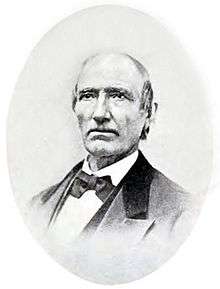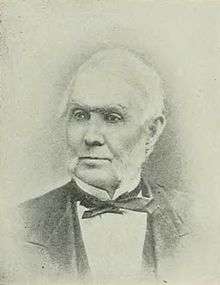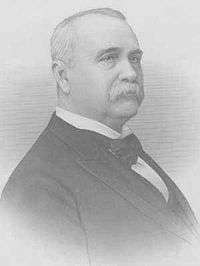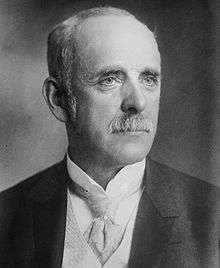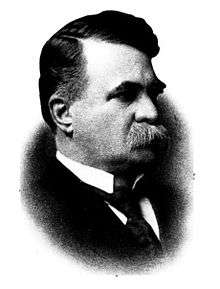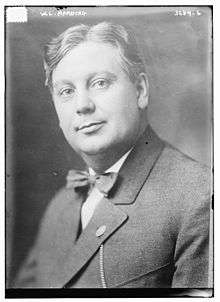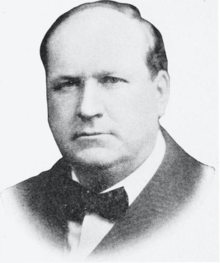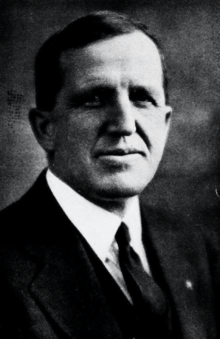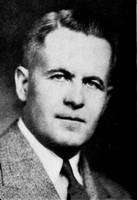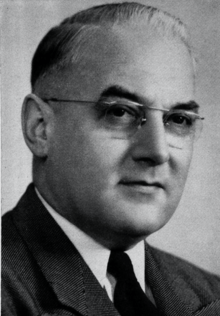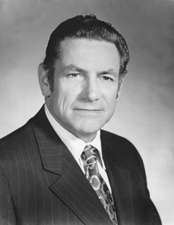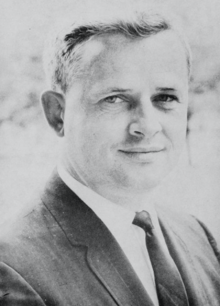List of Governors of Iowa
| Governor of Iowa | |
|---|---|
|
Seal of the State of Iowa | |
| Style | The Honourable |
| Residence | Terrace Hill |
| Term length | Four years, no term limits |
| Inaugural holder | Ansel Briggs; 1846 |
| Formation | Constitution of Iowa |
| Succession | Every four years, unless re-elected |
| Salary | $130,000 (2013)[1] |
The Governor of Iowa is the chief executive of the U.S. state of Iowa. The governor is the head of the executive branch of Iowa's state government[2] and is charged with enforcing state laws.[3] The governor has the power to either approve or veto bills passed by the Iowa State Legislature,[4] to convene the legislature,[5] and to grant pardons, except in cases of treason and impeachment.[6] The governor is also the commander-in-chief of the state's military forces.[7]
There have been 41 governors of Iowa. The longest-serving governor is Terry Branstad, who served from 1983 to 1999, was elected again in 2010 and took office on January 14, 2011. He is the longest-serving governor in U.S. history, surpassing the previous record of 21 years set by George Clinton. The shortest-serving governor was Robert D. Fulton, who served 16 days.
List of Governors
Governors of the Territory of Iowa
- For the period before Iowa Territory was formed, see the list of Governors of Wisconsin Territory.
Iowa Territory was formed on July 4, 1838, from Wisconsin Territory. It had three governors appointed by the President of the United States. The first governor did not arrive for six weeks after the territory had been created; in the interim, territorial secretary William B. Conway acted as governor.[8]
| # | Image | Governor | Took office | Left office | Appointed by |
|---|---|---|---|---|---|
| 1 | 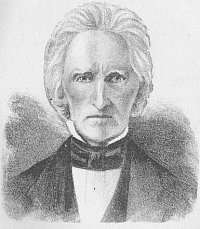 |
Robert Lucas | August 15, 1838 | May 13, 1841[lower-alpha 1] | Martin Van Buren |
| 2 | 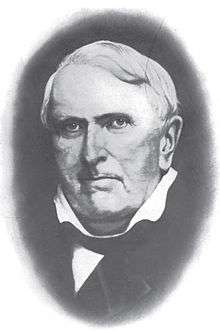 |
John Chambers | May 13, 1841[lower-alpha 1] | November 18, 1845[lower-alpha 2] | William Henry Harrison |
| 3 | 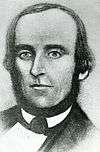 |
James Clarke | November 18, 1845[lower-alpha 2] | December 28, 1846[lower-alpha 3] | James K. Polk |
Governors of the State of Iowa
The southeast portion of Iowa Territory was admitted to the Union as the state of Iowa on December 3, 1846; the remainder became unorganized territory.
The first state constitution of 1846 created the office of governor, to have a four-year term,[11] with no specific start date for the term. The original constitution of 1857 reduced this term to two years,[12] but an amendment in 1972 increased this back to four years.[13] The 1857 constitution set the start of the term to the second Monday in the January following the election,[14] which was changed to the day after that by a 1988 amendment.[15]
The office of lieutenant governor was created in the 1857 constitution, elected for the same term as the governor.[16] An amendment in 1988 specified that the lieutenant governor would be elected on the same ticket as the governor.[17] If the office of governor becomes vacant, the office devolves upon the lieutenant governor for the remainder of the term or vacancy.[18] Prior to 1857, if the office of governor became vacant, the state secretary of state would act as governor.[19] There is no term limit on the number of terms a governor may serve.
- Parties
Democratic (10) Whig (1) Republican (31)
Living former U.S. governors of Iowa
As of May 2015, there are four former U.S. governors of Iowa who are currently living at this time, the oldest U.S. governor of Iowa being Robert D. Ray (1969–1983, born 1928). The most recent U.S. governor of Iowa to die was Leo Hoegh (1955–1957, born 1908), on July 15, 2000. The most recently serving U.S. governor of Iowa to die was Harold Hughes (1963–1969, born 1922), on October 23, 1996.
| Governor | Term | Date of birth (and age) |
|---|---|---|
| Robert D. Fulton | 1969 | May 13, 1929 |
| Robert D. Ray | 1969–1983 | September 26, 1928 |
| Tom Vilsack | 1999–2007 | December 13, 1950 |
| Chet Culver | 2007–2011 | January 25, 1966 |
Notes
- 1 2 Chambers was appointed on March 25 to the position of territorial governor, to take office when sworn in. He arrived in the state on May 12 and took office the next day. Lucas was out of the capital at the time and did not formally resign his commission until June 17, per a letter written to U.S. Secretary of State Daniel Webster.[9]
- 1 2 Clark was appointed on November 18;[10] it is unknown what specific date he assumed office.
- ↑ Although Ansel Briggs was sworn in as governor of the state on December 3, it remained a territory until December 28.[10]
- ↑ There is no official numbering, and different governors have interpreted it differently, based on if repeat terms are numbered.[20] This article includes numbering for every distinct term in office.
- ↑ The office of Lieutenant Governor was created in the 1857 constitution.[16]
- ↑ Lieutenant governors represented the same party as their governor unless noted.
- ↑ This indicates which terms a governor served; some served in multiple terms, indicated by a number with a trailing ellipsis (for those who started a term but did not finish it) or preceding ellipsis (for those who ended a term but did not start it), while others served for multiple terms, indicated by a given number range.
- ↑ Briggs was sworn into office 25 days before the state was formally admitted.[21]
- ↑ The election schedule changed during Grimes' term, switching to odd-numbered years and shortening his term by nearly a year.
- ↑ Lowe was the first governor elected under the 1857 constitution, which shortened terms to two years.
- ↑ Resigned to take an elected seat in the United States House of Representatives.
- 1 2 3 Resigned to take an elected seat in the United States Senate.
- 1 2 3 4 As lieutenant governor, filled unexpired term.
- 1 2 All sources state Boies was sworn in on February 27, 1890, with no explanation given for the delay.
- 1 2 Represented the Republican Party.
- ↑ Amendment 11 to the Iowa constitution, passed in 1904, shifted the state's election cycle forward one year, such that terms would begin on odd years. This lengthened Cummins' second term to three years, 1904 to 1907.
- 1 2 Died in office.
- 1 2 3 Represented the Democratic Party.
- ↑ Ray was the first governor elected following a constitutional amendment that lengthened terms to four years; his latter two terms were four years long.
- ↑ Governor Branstad's second term expires on January 11, 2019.
References
- General
- "Governors of Iowa". National Governors Association. Retrieved November 8, 2014.
- Constitutions
- "Constitution of the State of Iowa". Iowa General Assembly. 1857. Retrieved November 8, 2014.
- "Amendments to the Constitution of Iowa". Iowa General Assembly. 1998. Retrieved November 8, 2014.
- "Constitution of the State of Iowa". Iowa General Assembly. 1846. Retrieved November 8, 2014.
- Specific
- ↑ "CSG Releases 2013 Governor Salaries". The Council of State Governments. June 25, 2013. Retrieved November 23, 2014.
- ↑ IA Const. art. IV, § 1
- ↑ IA Const. art. IV, § 9
- ↑ IA Const. art III, § 16
- ↑ IA Const. art. IV, § 11
- ↑ IA Const., art. IV, § 16
- ↑ IA Const. art. IV, § 7
- ↑ Shambaugh, Benjamin F., ed. (1903). "The Messages and Proclamations of the Governors of Iowa". The Messages and Proclamations of the Governors of Iowa. 1. Iowa City, Iowa: State Historical Society of Iowa. p. 208.
- ↑ Executive Journal of Iowa 1838–1841, Governor Robert Lucas. State Historical Society of Iowa. 1906. pp. 277–279.
- 1 2 3 Benjamin F. Gue (1903). Iowa biography. Century History Company. p. 52.
- ↑ 1846 Const. article V, § 2
- ↑ IA Const. art. IV, § 2
- ↑ IA Const. amendment 32
- ↑ IA Const. art. IV, § 15
- ↑ IA Const. amendment 42
- 1 2 IA Const. art. IV, § 3
- ↑ IA Const. amendment 41
- ↑ IA Const. art. IV, § 17
- ↑ 1846 Const. art V, § 18
- ↑ "No 41st Governor for Iowa?". The Gazette (Cedar Rapids). November 5, 2010. Retrieved November 8, 2014.
- ↑ Secretary Of State, Iowa (1951). Iowa Official Register – 1951–1952. p. 97.
External links
- List of Governors of Iowa at NNDB.com
- Governor of Iowa


